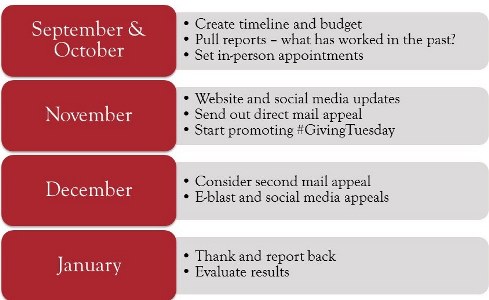It’s fall, so if you haven’t started planning your year-end appeals, you’re late—but not too late! Over 40% of giving occurs in last four months of year. But Google has found that donors begin their research in August, and that online donation-related searches increase 30% from August to September. Of course, December is still king for when those gifts are actually made.
So how do you capture donors’ attention in those late-summer months and move them into a meaningful gift by December? By avoiding common mistakes we see among nonprofits:
MISTAKE #1
Sending the first communication on November 29
We know starting early is a must. That doesn’t necessarily mean that you’re asking in September, but it should mean you’re planning and ramping up communication so that when a donor is thinking about where to give toward the end of the year, you have laid a solid foundation and built a great case for a gift. Use the early fall to show impact and tell your story so your organization is top of mind.
MISTAKE #2
No board support
One of the first pieces of the puzzle you need in place is board support. This means all board members should have made meaningful personal gifts and are thinking about other ways to get involved—making calls, setting appointments, giving tours, signing appeal letters and thank-you cards, or maybe considering issuing a challenge gift to the community. The reality is, board members will not wake up one morning and think of these ideas themselves. You, as a staff leader, need to communicate with them early at board meetings and through one-on-one conversations to help them get engaged and maximize success.
MISTAKE #3
Employing the “wait by the mailbox” strategy
One of the biggest mistakes you can make is assuming that last year’s gifts will be repeated, especially for your top donors. You must ask—and for your top donors, this should be in person and prior to December. Sitting down with your donors and prospects for specific in-person asks does so much—to not only secure higher-level gifts, but also to build a relationship. Bottom line: If your strategy does not involve in-person meetings, you are leaving serious money on the table.
MISTAKE #4
A message that misses the mark
It’s vital to have a coordinated message that is clear to donors. It needs to:
• Use a multipronged approach (in-person, direct mail, online and social media)
• Make sure written and electronic communications complement each other
• Tell strong stories that tap into donor emotions
• Demonstrate impact
One of the top reasons donors say they stop giving to an organization, besides their not being asked, is that no one reports back on what their gift did before they are asked for the next one. Now is the time of year to get those messages out, if you have not already started doing so. When creating the materials, remember you don’t have to spend an enormous amount of money—it should be appropriate for your organization and mission. Donors don’t want to see a small human services organization with highly flashy materials, but they may expect that from their university, or a statewide arts group.
MISTAKE #5
Only contacting people who haven’t given yet
If you’re only contacting those that haven’t given yet, you are leaving dollars on the table. The people who already made an investment in your organization this year have demonstrated they are interested in your mission! Don’t ignore this pool of possible repeat givers. Speaking of the past, another really important point to consider is what worked well in your previous year-end communications. Pull records on the last three years’ appeals and compare them to the results. Did one outperform the others? Build on that. Also look at drop dates compared to response—all of this data will tell you how and when your donor base likes to be communicated with.
MISTAKE #6
Your website isn’t donor-friendly
While online giving is less than 10% of giving overall, December is the biggest month by far for these gifts, so it’s important that you are leveraging this channel. A donor-friendly website will be:
• Clean and easy to navigate
• Mobile optimized
• Clear about what your organization does
• Easy for visitors to find the donate button (preferably large and at the top of the page)
Your e-giving strategy should include e-blasts that weave together messages of impact, solicitation and gratitude—so, not every email should be a solicitation. Consider sending testimonials or creative “thank you for your support” messages using engaging stories in between solicitations. This pattern should also be how you use social media to drive traffic back to your website. And don’t forget to plan around #GivingTuesday!
MISTAKE #7
Forgetting to follow up
While we know December is exhausting, don’t use January for an organizational nap! Send impact statements, testimonials or thank-you postcards. And don’t forget to involve your board and staff in this process. Was this the year you raised the most money? Report it, and tell them what you are going to do with the dollars!
Feel free to use this timeline summary in your planning:

Remember, the biggest mistake of all is not asking!




Leave a Reply